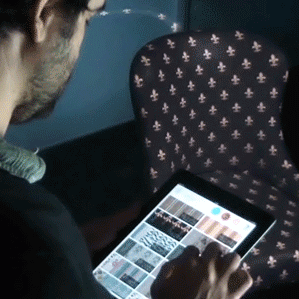Furniture Shopping with Augmented Reality
In a darkened room in the back of a small furniture store just south of San Francisco International Airport, the couch in front of me keeps changing colors and patterns, from red to blue to beige to a gray, white, and green pattern.

The couch is real—I can reach out and poke the cushions—but the psychedelic surface-shifting effect is created with augmented reality technology that projects fabric patterns onto the surface of the couch (which in reality is a boring shade of gray).
This is the work of Vizera Labs, whose cofounders imagine a future where brick-and-mortar stores could be replaced by smaller, cheaper, simpler spaces whose expensive physical inventory is replaced by virtual designs that can be projected onto just a few floor models.
While it could allow companies to open smaller stores, it could also let customers get a better idea of how a pattern or color will look across a piece of furniture or the walls of a room.
“They can still touch the swatches, so there is no shortcoming of the tactile feeling side of it,” says cofounder Ali Çevik.
So far, Vizera’s setup has been installed in a handful of furniture stores, some of which are paying subscription fees for the equipment and fabric imagery. Two of the stores are in cofounders Çevik’s and Mert Küҫük’s native Turkey, and three are in the United States. One of these is in a San Francisco showroom for French modern furniture company Ligne Roset, and Çevik says the technology is also being installed in that company’s Paris store.
Çevik and Küҫük took me to a small store called Cre8 a Couch in Burlingame, which also uses Vizera technology. You can use an iPad to tap between different realistic-looking fabric options that change via an overhead projector. This video gives an idea of what it looks like in person.
Vizera takes a 3-D scan of a piece of furniture, and uses software to segment the resulting 3-D model into pieces, similar to the way in which an upholsterer would when covering furniture. Vizera also digitizes upholstery options by scanning materials like fabric and leather in a way that aims to keep the colors, textures, and patterns as consistent as possible with the actual swatches.
The company then uses the 3-D model to simulate upholstering the couch with the digitized fabric, and from that it calculates the depth and scale details of the image that the projector will shine onto the actual piece of furniture in the store. A depth camera connected to the projector is used to line up the image with the actual furniture.
The technology looks impressive, though it still needs work: when I see it at Cre8 a Couch in Burlingame, the projection is slightly misaligned with the couch, even after Küҫük re-registers the real couch’s location with Vizera’s server; and if I were to move the carefully positioned throw pillow, it would screw things up, too.
Customers seem to like it. Elnaz Davoudi, a design consultant at Cre8 a Couch, says having Vizera in the store makes it easier for them to visualize how the fabrics they’re considering will look on a real couch. And this is often a part of the buying process where people hesitate since they’re not sure if they’re making the right decision. “This will take that part out of the equation, which is really nice,” she says.
Keep Reading
Most Popular
Large language models can do jaw-dropping things. But nobody knows exactly why.
And that's a problem. Figuring it out is one of the biggest scientific puzzles of our time and a crucial step towards controlling more powerful future models.
The problem with plug-in hybrids? Their drivers.
Plug-in hybrids are often sold as a transition to EVs, but new data from Europe shows we’re still underestimating the emissions they produce.
Google DeepMind’s new generative model makes Super Mario–like games from scratch
Genie learns how to control games by watching hours and hours of video. It could help train next-gen robots too.
How scientists traced a mysterious covid case back to six toilets
When wastewater surveillance turns into a hunt for a single infected individual, the ethics get tricky.
Stay connected
Get the latest updates from
MIT Technology Review
Discover special offers, top stories, upcoming events, and more.